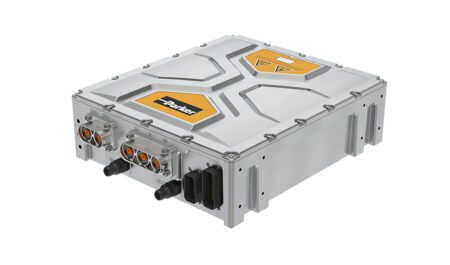Steyr has unveiled the latest stage in its ‘Konzept’ development, with the release of details concerning the Hybrid Drivetrain Konzept following on from the display of the original ‘Konzept’ tractor at Agritechnica 2019.
A key research focus has been on the benefits of electric drive systems with the potential to power a lightweight, high-horsepower tractor delivering fuel consumption advantages averaging 8%. These benefits also mean new levels of driving experience and performance.
Christian Huber, global tractor product management, explains that the HybridDrivetrain Konzept has been created from the diesel/electric hybrid knowledge gained following the development of the Steyr Konzept tractor.
“In detail, the Hybrid Drivetrain Konzept follows the line of thinking of the Konzept tractor,” says Huber. “It shows where we are heading, especially in terms of transmissions and features which may find their way into tractors in the future.
As with any vehicle, when it is driving on the road its speed has to be reduced as it approaches, for example, a roundabout or crossing. The key to efficient road travel is how quickly a vehicle can regain the speed when exiting the roundabout or crossing. The electric drive system eases the return to the top travel speed, which we can now achieve faster than with a conventional transmission.
“It is also much more efficient at retaining as much as possible of its maximum travel speed when driving uphill,” says Huber. “This is mainly driven by applying super capacitor technology, which enables us to boost the tractor’s power when there is greater demand, providing up to 25% faster acceleration. The same is true when working in the field with implements to cover peak load in high draft applications.”
Other benefits from the development of electric drivetrain power include reduced turning radius. Electric drive allows the speed of the front axle to be increased when turning, creating an active turn effect that is especially beneficial at headland turns. Compared to a conventional tractor of the same wheelbase fitted with the same tyres, the turning radius is cut by around 1.5 metres.
The Hybrid Konzept is also capable of transferring power to an implement, via high-voltage sockets front and rear, Huber explains.
“Transferring electrical power to the implement wheels can help the tractor-implement combination as a whole to gain additional traction, and potentially allow a bigger implement to be used than might otherwise be possible with the size of tractor.
“This offers work-rate benefits, and in addition it’s possible to use electrical power for implement requirements such as the electrical drives of planters, fertiliser spreaders or trailed sprayers.”
There are also electric drive advantages for the Hybrid Drivetrain Konzept’s tractive efficiency, he says.
“With differential front/rear torque vectoring, we can direct torque to the front or rear as required and enable both axles to work at their optimum, providing up to 10% extra drawbar power. Complemented by 4wd, this allows the tractor to overcome extreme conditions.
“This means we have created a variable, on-demand 4wd system, minimising the usual front axle slippage seen on a conventional tractor working with a soil-engaging implement. As a result, it reduces fuel consumption and soil damage too.
“We have also integrated a unique brake retarder, which enables a tractor incorporating this drivetrain to maintain a constant speed when travelling downhill. In fact, the brake retarder, in combination with S-Brake, can significantly reduce the need for braking, even with a heavy load on a trailer. Benefits include reduced brake wear and enhanced safety. Furthermore, the brake retarder is used to recharge the super capacitors.
“We plan to show the Hybrid Konzept at future agricultural exhibitions and fairs, and while it remains a conceptual study that will not enter production in itself, some of its conceptual ideas may be seen at some point in future on STEYR products.”





